Winding Through Chianti
We picked up our new lease car, a Peugeot 207, from Rome’s airport to drive us through Italy and France over the next 2 months. It comes with a portable GPS (and a 30 second training session) – which we’ve never had the need to use before – and it’s been a huge learning curve on how to manipulate it so that it becomes your friend rather than your enemy.
Our GPS speaks to us in a commanding and cultured British-accented female voice. She sounds as though she would be a twin-set and pearls kind of gal. We’ve named her Miss Moneypenny, as in James Bond’s secretary. Miss Moneypenny is certainly worth her weight in gold pennies but that’s not to say she’s always right. There’ve been many occasions when Max has sworn his head off at her. She’s confused me, Navigator number 2, by comments such as “Turn right” on mountainous hairpin bends. Oh what, as opposed to going over the edge? We’ve plenty of time, Miss Moneypenny and I, to get very well acquainted.
Grapes, wild boar, pungent black truffles, olive oil, chianti classico wine and porcini mushrooms – these are the staples of the Chianti area and what we found on typical Chianti menus.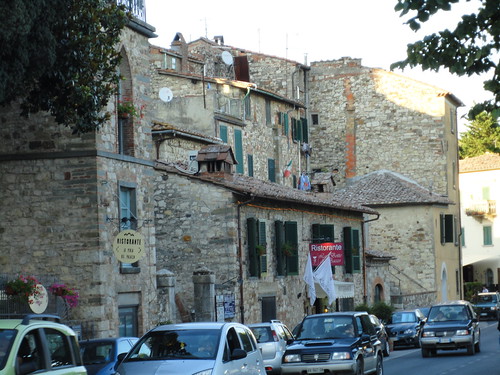 |
| Radda-in-Chianti |
We didn’t realise that the rolling hills of central Tuscany were so forested. Anticipating it to be mostly cultivated land of neat rows of vines with the occasional line of cypresses was only part of the picture. Thick woodlands cover the slopes and surround farmlets. Narrow winding roads climb and descend Tuscan hills, sometimes passing through canopies of forest trees. Villages, stone castles and farmhouses nestle in amongst all the greenery.
 |
| Small cafes tucked away in small corners of piazzas, Radda-in-Chianti |
The area we chose to stay in had pretty villages and hamlets with melodic names like Castellina-In-Chianti (beautiful medieval stone tunnel streets and a small square-towered castle), Radda-In-Chianti (pretty little piazzas), Greve-In-Chianti (cool arched arcades surround the medieval piazza and has historical links with Verrazzano who discovered New York’s harbour), Panzano (where Max scored a free bottle of white Chianti through a raffle held outside in the village piazza) and Montefioralle (a gorgeous tiny medieval stone village). If you say these names with a broad Italian accent you get the right melody. Florence lies to the north and Siena to the south.
 |
| Tiny 3-wheeler for tiny streets, Panzano |
By the way, when do hills become mountains? I’ve always wanted someone to explain the difference to me. Any ideas? Some of those hillslopes were very steep and scary whilst I sat white-knuckled in the passenger seat as we reached high elevations then went back down again, with only the occasional gasp of fear as cars or the irregular truck approached from the opposite direction when it looked like there was room only for one of us on the road. On the other hand, Max with cool nerves carefully wound the car around tight bends and mountain-edged slivers of tarmac, only twice having to coax the car into a 3-point turn to get around sharp z-bends. A few days of this kind of driving and then I began to relax. Luckily the roads were relatively quiet which surprised us considering it was peak summer season.
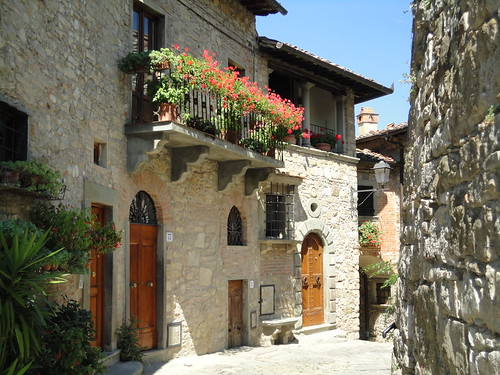 |
| Montefioralle |
As well as enjoying the food and wine of the district, we stayed at two countryhouse B&B’s. The first was in a rustic farmhouse set high up near a national park and the second was a charmingly decorated country house by the name of Il Casello with a lovely pool and gorgeous countryside views. The area has vineyards, cellars and olive groves and is loaded with wild boar as well as wild deer. Gunshots at dusk can be heard at times ringing around the countryside with the distant sound of the hunters’ barking dogs. Feral piggy-wig sausage would be arriving on someone’s plate soon.
A moment of surprise happened as we headed back to our accommodation at dusk after a pasta dinner at one of the local villages. A stout wiry-haired tusked boar emerged from the edge of the forest and stood by the road as Max slowed down the car to take the bend. Whoa!! A boar with road sense! The only time we got close to seeing one after that was on Tuscan menus (wild boar sausage, wild boar casserole, wild boar and truffle pasta sauce) and hanging up in the form of dried salamis in macellarias (butchers) and in supermarkets. Motoring us around the neighbourhood, Max made the challenging drive up to the historic Antinori wine estate of Badia a Passignano to sample the local vino. The estate is very picturesque set across hills and valleys with typical Tuscan-style buildings. Pricey wine tastings are held in a restored 18th century building that also houses a restaurant. On site we explored the exterior of an extremely old abbey with a fascinating history and frescoes, but we were disappointed to find that it was closed for renovations when we were there.
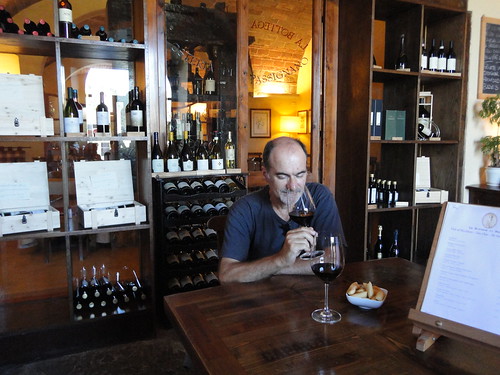 |
| Antinori wine estate of Badia a Passignano |
A short and sweet, although hot, reunion with medieval Siena after a 17 year absence was a daytrip away from our Chianti nest. The Piazza Il Campo was packed with rammed earth, embedded with horse hoof imprints from the Il Palio – Siena’s famous horse race where jockeys in their satins tear around the piazza on bare-backed highly strung steeds to win the honour of a flag. Leading up to the main race are many trials and parades in the preceding month. Team Giraffa (the Giraffes) had won and their colours flew from flagposts outside palazzo buildings.
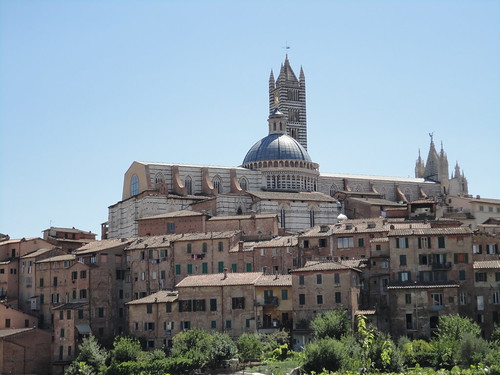 |
| Siena and Duomo Cathedral |
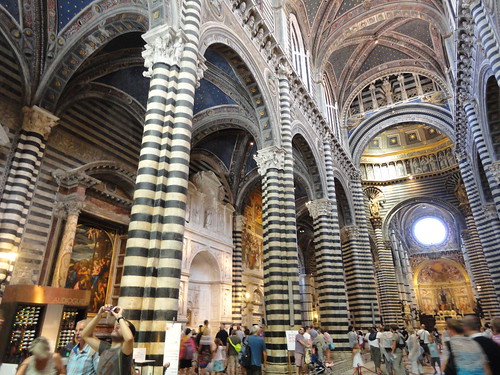 |
| Siena's Cathedral |
Great gelati was a memory of our previous visit to Siena so we scoured the gelaterias for the best to taste. Artiginiale, which refers to it being handcrafted, is a label we look out for as well as judging the colour of the gelati – too brightly coloured is a no-sale for us. Max chose his favourite lemon whilst I indulged in my favourite flavour of the day – sometimes it can be rockmelon, other times it can be coconut, caramel, raspberry….
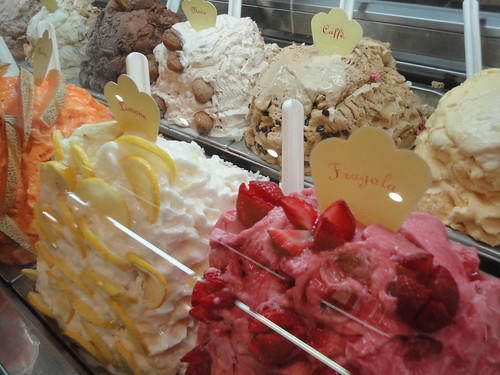 |
| Gelati - confused for choice! |
These have been some of the flavours of Chianti for us on our sensory meander through the sights, sounds and tastes of this one small section of the region.


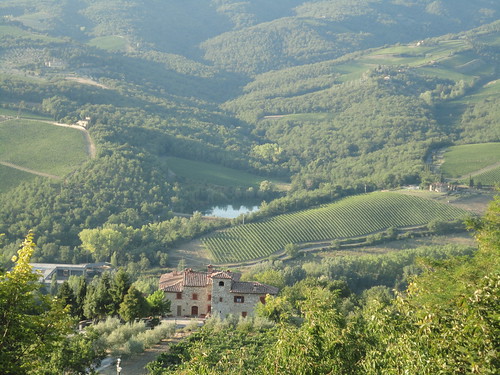
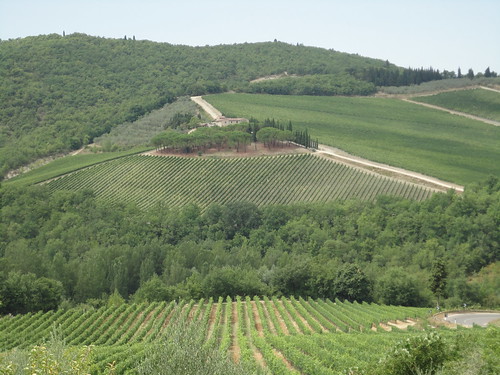
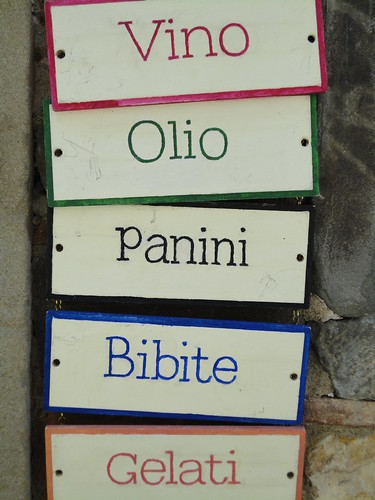
 Hi, I'm Eva - world traveller, cultural explorer and experience seeker. Together with my husband Max, we've been globetrotting for over 20 years.
Hi, I'm Eva - world traveller, cultural explorer and experience seeker. Together with my husband Max, we've been globetrotting for over 20 years.







0 comments: